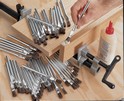How to Clean Glue and Gunk
From Your Woodworking Tools and Equipment
 Any one of us that has spent more than a minute or two in the woodshop has certainly made a mess. For better or for worse, these messes often involve glues, adhesives, or other such goopy, gummy gunk. Of course, it is the nature of these substances to stick and, more often than not, to stick to a handful of surfaces aside from the one they’re intended for. Accordingly, we craftsmen require an arsenal of solutions to eliminate this gunk and to keep our hand tools and woodworking equipment in good, clean, working order. Fortunately, that arsenal is easy to find and easy to use; simply employ the below information to maximaize your shop and the equipment in it.
Any one of us that has spent more than a minute or two in the woodshop has certainly made a mess. For better or for worse, these messes often involve glues, adhesives, or other such goopy, gummy gunk. Of course, it is the nature of these substances to stick and, more often than not, to stick to a handful of surfaces aside from the one they’re intended for. Accordingly, we craftsmen require an arsenal of solutions to eliminate this gunk and to keep our hand tools and woodworking equipment in good, clean, working order. Fortunately, that arsenal is easy to find and easy to use; simply employ the below information to maximaize your shop and the equipment in it.
First, because keeping your tools and working environment clean is an integral characteristic of producing quality craftsmanship, one should always keep a liberal quantity of one or a few of the following (generally mild) solutions in the shop: WD-40, lacquer thinner, turpentine or denatured alcohol. Denatured alcohol is also known as methylated spirits and is essentially ethanol with chemical additives that make it, more or less, extremely poisonous. So, although I hope there is little temptation to consume any of these solvents, don’t drink it. All of these chemicals can be highly dangerous and are extremely flammable. Accordingly, although incredibly helpful to have about the shop, be very cautious with using and storing these solutions; chemical solvents can injure or kill when abused or used foolishly or improperly.
Because they are often used as multipurpose cleaners, these solvents are relatively easy to come by; in fact, you may purchase them at any home improvement or hardware store and usually from your local supermarket as well. These solvents can quickly dissolve wood glue and other industrial adhesives and, in effect, keep your equipment shining clean. (Note: speaking of multipurpose cleaners, you may also use the “green” or organic multipurpose cleaning solutions you’d find on your grocery store’s cleaning isle; they are effective, economical, and you can use them in the house as well as in the shop.)
To attack a gluey or gunky mess, simply arm yourself with one of these solvents, a pair of latex gloves and a clean shop rag. While wearing these latex gloves, apply an appropriate amount of solution to a clean shop rag and commence assault on your problem areas; in other words, simply scrub the gunk away and repeat this process until you have satisfactorily cleaned your equipment. I would also recommend that you employ this practice a little more frequently than just for messy clean-ups; in fact, you should thoroughly rub/wipe down your tools after every use. Also, it is important that you wash/rinse your tools (and rags) after treating them with chemicals.
Although the aforementioned solvents should manage most gunks, if your mess requires something a little more intense than lacquer thinner or denatured alcohol can deliver, you have a few other cleaning options in the form of mineral spirits and acetone. Because these solutions are more dangerous, though, you must understand and respect these chemicals before you employ them, they are seriously hazardous and extremely flammable – handle them with care and caution.
As for their application, though, use and apply the solutions in the same manner as expressed above. Absolutely wear gloves (you might also wear a mask), apply to a clean shop rag and rub away residual gunk. Thoroughly wash your tools, rags and hands after employing both mineral spirits and acetone and properly store these solvents when you’re finished using them.
And that is just about that. It is good practice to keep your tools clean and to clean them regularly. Clean tools build better project and altogether produce better result and deliver a better working experience.













